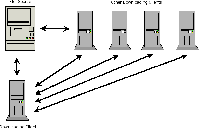Bandwidth Throttling
From Computing and Software Wiki
Bandwidth throttling is a practice sometimes undertaken by Internet service providers (ISPs) to either reduce the traffic on their network, or to inhibit certain types of traffic. This is done in order to improve the experience of other network users or traffic types. One method of bandwidth throttling is called a bandwidth cap, which limits how much data a single user may use before being cut off. Another method is traffic shaping, which limits the speed of certain types of Internet traffic. Recently there have been some social/legal concerns over large corporations restricting traffic in this manner as it benefits several of their other offerings unfairly.
Contents |
Reasons for Throttling
Organizations which practice bandwidth throttling cite that 95% of their users are negatively impacted by the large bandwidth consumption of a few heavy use bandwidth consumers.[1] The large consumption comes from users accessing large files over their ISP's network, such as music, streaming video, movies, etc. In recent years high-bandwidth content has become increasingly commonplace online, and thus the load on ISPs has increased as well. These large files can take a long time to download, and to help reduce this time, many users download via BitTorrent. BitTorrent can increase download speeds as it not only allows you to download the file from the original host, but to download pieces from other users downloading the file as well, vastly increasing the sources to download from simultaneously. BitTorrent can greatly increase the load on a network as not only does a single user download its file from many instead of one, but while they are downloading they also upload pieces they have to other users also downloading the file.
During peak hours when network use it at it's highest some ISPs are finding that users who are only accessing web pages and using low bandwidth services like instant messaging are finding their network speeds degrading due to the high user of a few high bandwidth users. If bandwidth throttling techniques are implemented on a network experiencing this congestion, high bandwidth users would have their usage reduced, increasing the performance of the lower bandwidth users on the network.
Throttling Methods
Bandwidth Cap
Bandwidth caps are a simple method of bandwidth control used by ISPs, which limits the amount of bandwidth (upload and/or download) a user may use within a certain time period. This method has been commonplace for years, and although not all people agree with a bandwidth cap there has been few debates about the practise as it is applied neutrally to all, based on the ISP one registers with. ISPs typically offer a pay per gigabyte option for use beyond the maximum bandwidth limit.
Traffic Shaping
Traffic shaping occurs when certain types of Internet traffic are discriminated against in comparison to others; such to limit the speed of packets associated with certain types of applications. The simplest method to achieve this is to read the destination port from the packets entering their network, and if it corresponds to a port commonly used by a P2P application (such as a BitTorrent client), then limit the traffic associated with this type of packet. Most Canadian ISPs are now engaging in some form of traffic shaping, most limit BitTorrent bandwidth on their networks.[2] Some applications now let the user select a custom port to use, to attempt to avoid this bandwidth throttling, or to encrypt the packets so that the type of application associated with the data will be indistinguishable to the ISP. In response to these changes some ISPs are now simply blocking encrypted traffic (such as Rogers), making the assumption that encrypted traffic will degrade their network performance.[2]
Social Issues
Under the Canadian Radio-television and Telecommunications Commission (CRTC), Bell Canada (Bell) provides access to its network to various members of the Canadian Association of Internet Providers (CAIP).[1] Bell has, without agreement from those ISPs which pay for network access, begun bandwidth throttling across its entire network, not just for users resisted with Bell as their ISP. This act as raised the issue of fair competition as with the entire network being bandwidth throttled, the various companies providing independent ISP services using Bell's network in turn provide a bandwidth throttled service to their customers. CAIP argues that this is unfair as the throttling reduces the quality of high bandwidth services on their networks, while Bell offers competing high bandwidth services on their satellite networks with on demand services that are not bandwidth throttled. CAIP claims this makes a unleveled playing field and has asked the CRTC to stop Bell's throttling for the ISPs using Bell's network. [3]
Additionally there are other concerns among internet users, especially high bandwidth users, in regards to who has the authority to limit their use, when most ISP agreements only indicate bandwidth capping is in pace, and not traffic shaping.
References
1. Chris Sorensen, "CRTC asked to stop Bell's 'throttling'," Toronto Star: Business. (Saturday April 5, 2008)
2. Azureus Wiki A popular BitTorrent client Wiki page
3. Canadian Association of Internet Providers Independent Internet Providers Take Bell to Task
See Also
External Links
Rogers Communications Inc. High Speed Internet Comparison
Canadian Radio-television and Telecommunications Commission
Canadian Association of Internet Providers
Signature
--Mcconkbp 01:02, 9 April 2008 (EDT)

